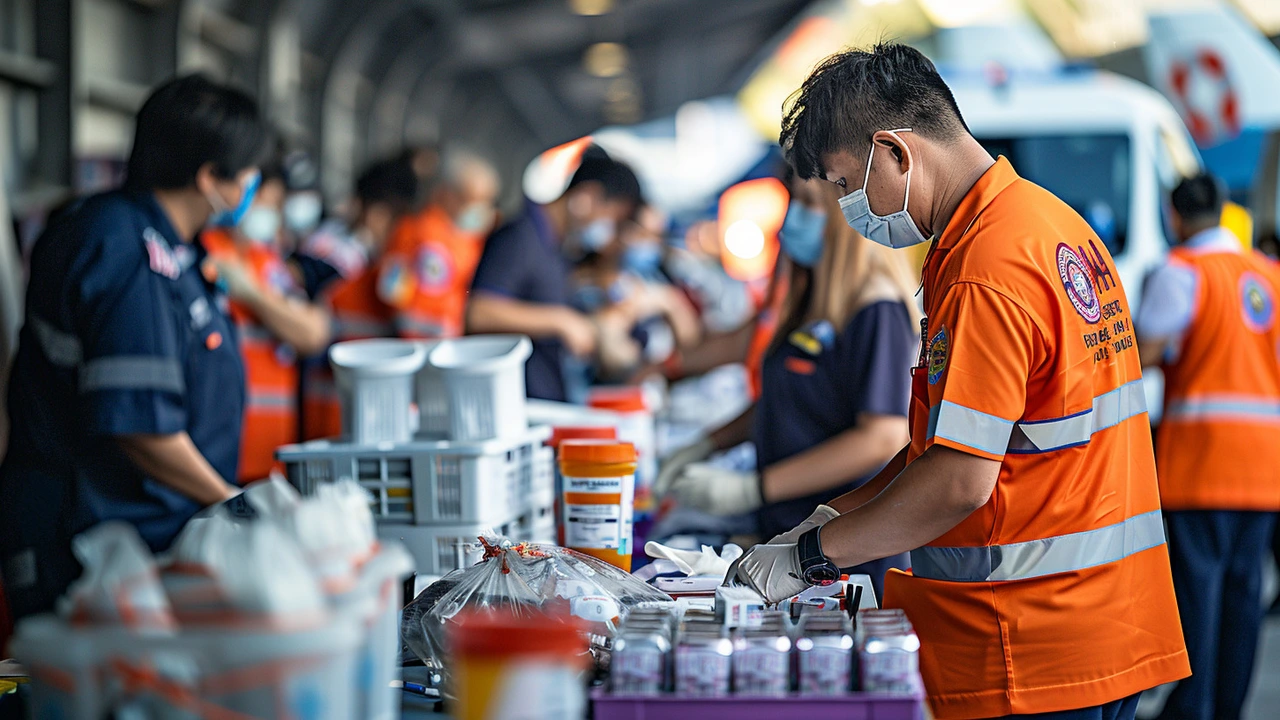Severe Turbulence Leads to Tragedy on Singapore Airlines Flight
In a tragic incident, a Singapore Airlines flight from London to Singapore experienced severe turbulence, resulting in the death of one passenger and injuries to several others. The flight, numbered SQ321, was en route to Singapore when it encountered extreme turbulence, causing significant distress and injuries among those on board. The airline has expressed its profound condolences to the family and friends of the deceased passenger.
Details of the Incident
The flight, operated by a Boeing 777-300ER, was carrying 211 passengers and 18 crew members. The turbulence struck midway through the journey, compelling the flight crew to divert and make an emergency landing at Suvarnabhumi Airport in Bangkok. The aircraft touched down at 3:45 pm local time, where emergency services from Samitivej Srinakarin Hospital were on standby to provide immediate medical assistance to the injured.
Passengers described the terrifying experience as the plane suddenly hit violent turbulence, causing items to be thrown around the cabin and passengers to be jolted out of their seats. Despite the seatbelt sign being turned on, the force of the turbulence was such that it resulted in injuries ranging from minor bruises to serious trauma. The airline reported that flight attendants acted swiftly to secure the cabin and assist passengers during the ordeal.
Emergency Response
Upon arrival in Bangkok, a line of ambulances was seen at the tarmac to transport the injured passengers to nearby medical facilities. Footage from the scene showed the efficient mobilization of emergency response teams, demonstrating the preparedness of Bangkok's airport authorities for such critical situations. Hospital staff confirmed that several injured passengers received prompt medical attention, and critical cases were immediately stabilized.
Singapore Airlines has extended its deepest sympathies to the family of the deceased and assured that they are doing everything possible to support them during this difficult time. The airline is also coordinating with local authorities and international aviation bodies to conduct a thorough investigation into the incident, aiming to understand the causes and prevent such occurrences in the future.
Ongoing Investigation
While the specific details of what caused the severe turbulence are still under investigation, initial reports suggest that the aircraft encountered a sudden and powerful weather phenomenon. Turbulence, while common in air travel, can occasionally be severe and unpredictable, posing risks even in the most controlled environments. Experts emphasize the importance of adhering to safety instructions, such as keeping seatbelts fastened when seated, to mitigate injuries during turbulence.
The aviation community is closely monitoring the situation as investigations proceed. The incident underscores the need for continuous advancements in weather prediction technologies and in-flight safety protocols. Singapore Airlines is committed to collaborating with regulatory bodies to enhance passenger safety and ensure that such tragic events are avoided in the future.

Impact on the Aviation Industry
This incident has resonated within the aviation industry, prompting airlines worldwide to revisit their safety protocols and emergency preparedness strategies. Although turbulence is an unavoidable aspect of air travel, its impact can be mitigated through rigorous training and updated safety measures. Airlines are urged to incorporate lessons learned from such incidents to improve overall passenger safety.
Furthermore, this tragic event has highlighted the crucial role of emergency response teams at airports. The swift and efficient handling of the situation by Bangkok’s emergency services is a testament to the importance of preparedness and coordination in crisis situations. Airports globally may take this incident as a case study to evaluate and enhance their own emergency response systems.
Support for Passengers and Crew
In the aftermath of the incident, Singapore Airlines is providing support to the passengers and crew who were on board. Counseling services and medical assistance are being offered to those who were affected, ensuring that both their physical and emotional needs are addressed. The airline is also in constant communication with the passengers to provide updates on the investigation and assistance with any travel disruptions caused.
This support extends to the crew members who, despite the traumatic experience, acted with professionalism and care. Singapore Airlines appreciates their dedication and is ensuring they receive the necessary support to recover from this distressing event. The airline's response highlights the importance of strong internal support systems in managing post-incident recovery for both passengers and staff.

Future Safety Measures
As the aviation industry reviews the incident, there are calls for improvements in turbulence detection and avoidance. Technological advancements in weather radar systems and real-time data sharing between aircraft and ground stations are seen as essential steps in enhancing flight safety. Airlines are also encouraged to invest in advanced training programs for pilots and cabin crew to better manage unexpected severe weather events.
Passengers are reminded of the significance of following safety instructions and the role they play in their own safety during flights. Securing personal belongings, abiding by seatbelt signs, and remaining calm during turbulence are crucial actions that can help minimize injuries. The incident is a sobering reminder of the unpredictable nature of air travel and the collective responsibility of airlines and passengers to uphold safety standards.
In conclusion, the turbulence encountered by Singapore Airlines Flight SQ321 has left a profound impact on all involved. As the investigation continues, the focus remains on understanding the causes and enhancing safety measures to prevent future tragedies. The aviation community's commitment to learning from this incident and improving safety protocols will be pivotal in ensuring the safety and well-being of passengers worldwide.







Gerald Hornsby
May 23, 2024 AT 01:20 AMThe heavens grew angry, turning our journey into a chaotic ballet of fury. 😅
Hina Tiwari
May 23, 2024 AT 01:28 AMOh my gosh, that sounds absolutely terrifying – my heart goes out to everyone who lived through that nightmare. I can only imagine the shock and the fear that swept through the cabin, and I hope the survivors are getting the care they need. Stay strong, and please keep us updated on any news.
WILL WILLIAMS
May 23, 2024 AT 02:43 AMWow, talk about a wild ride! That turbulence was a brutal reminder that the skies can turn into a roller‑coaster in seconds.
Barry Hall
May 23, 2024 AT 02:50 AMIndeed, safety briefings are crucial; always keep that seatbelt fastened. 😊
abi rama
May 23, 2024 AT 04:06 AMWhile the incident is heartbreaking, it also shows how quickly crews can act and how resilient passengers can be.
Megan Riley
May 23, 2024 AT 04:15 AMHey there!!! I’m so sorry to hear about this - truly a tragic event!!! Remember, you’re not alone; reach out for counseling and stay linked with the airline for updates!!! Take care of yourself!!!
Lester Focke
May 23, 2024 AT 05:30 AMThe recent turbulence episode involving Singapore Airlines Flight SQ321 constitutes a salient exemplar of the inherent volatility of atmospheric dynamics. While turbulence is a ubiquitous phenomenon within the aeronautical domain, its extremities elucidate deficiencies within contemporary predictive meteorological frameworks. The unfortunate fatality underscores the exigency for a rigorous reassessment of safety protocols pertaining to seat‑belt enforcement and cabin preparedness. Furthermore, the commendable response of the Bangkok emergency apparatus bespeaks a paradigm of operational readiness that should be emulated globally. It is incumbent upon regulatory bodies, notably the International Civil Aviation Organization, to promulgate enhanced standards for real‑time turbulence detection. Advancements in LIDAR and satellite‑based atmospheric monitoring could, in theory, furnish pilots with anticipatory data of unprecedented fidelity. Moreover, the integration of such technologies must be accompanied by exhaustive pilot and crew training regimens to ensure adept mitigation. The psychological sequelae experienced by survivors warrant comprehensive post‑incident counseling, a facet oft neglected in post‑crisis debriefings. From an engineering perspective, the structural resilience of the Boeing 777‑300ER remains commendable, yet the incident invites scrutiny of interior cabin anchorage systems. The deployment of additional restraint mechanisms for portable items could ameliorate injury incidence during abrupt aerodynamic perturbations. In addition, the airline’s provision of transparent communication channels with affected passengers is a requisite component of corporate responsibility. The observed solidarity among the crew, manifest in their swift assistance, reflects the efficacy of Singapore Airlines’ internal support architecture. Nonetheless, the incident serves as a stark reminder that even the most meticulously orchestrated flight operations are susceptible to the caprices of nature. Consequently, a synergistic collaboration between meteorologists, aerospace engineers, and airline operators is paramount to curtailing future tragedies. In summation, the confluence of technological innovation, procedural rigor, and humanitarian consideration must coalesce to elevate the standards of aerial safety.
Naveen Kumar Lokanatha
May 23, 2024 AT 05:36 AMThanks for the detailed breakdown. It’s clear we need better tools and training. Let’s work together on sharing data across airlines and agencies. I think the community can push for those improvements.
Alastair Moreton
May 23, 2024 AT 06:53 AMHonestly, this is just another boring safety reminder that no one reads.